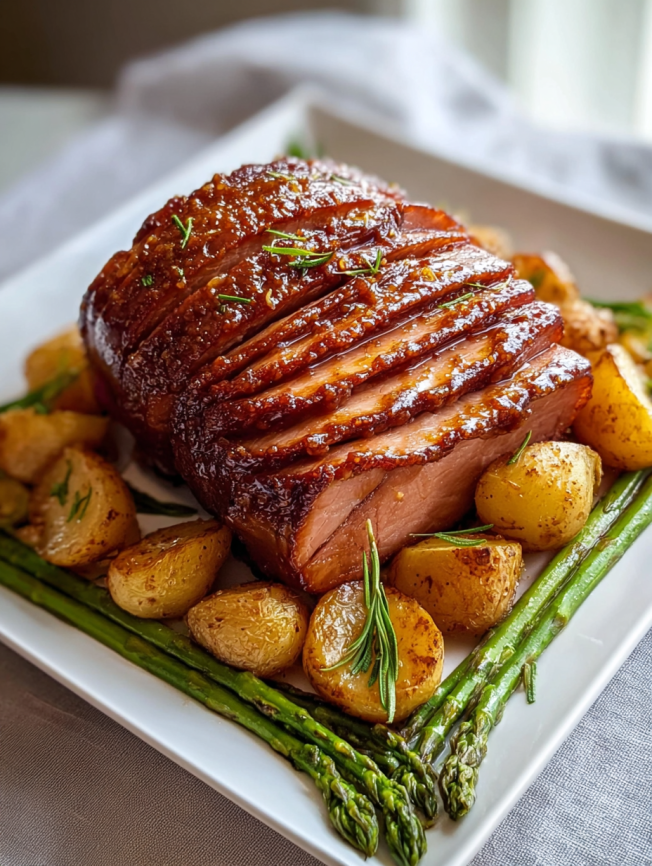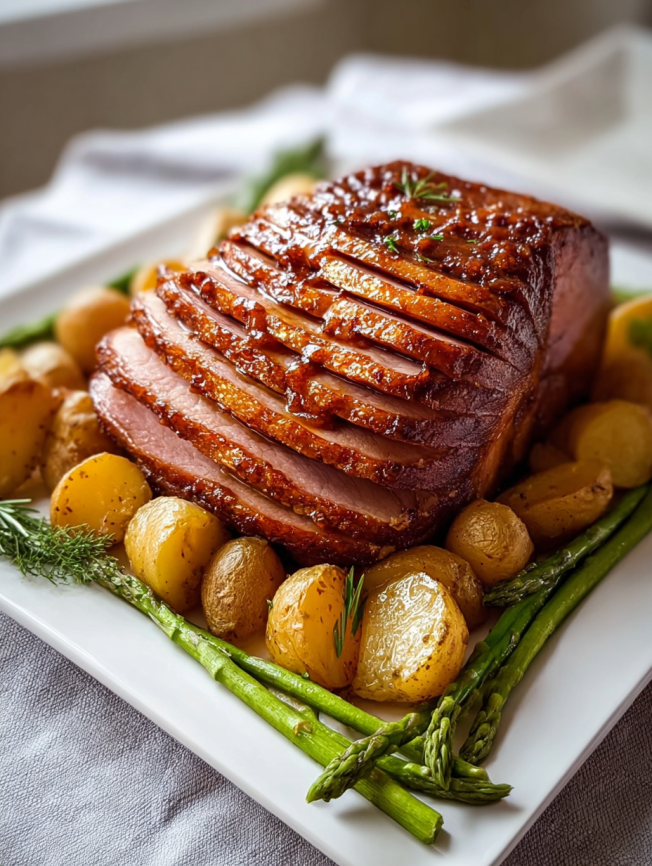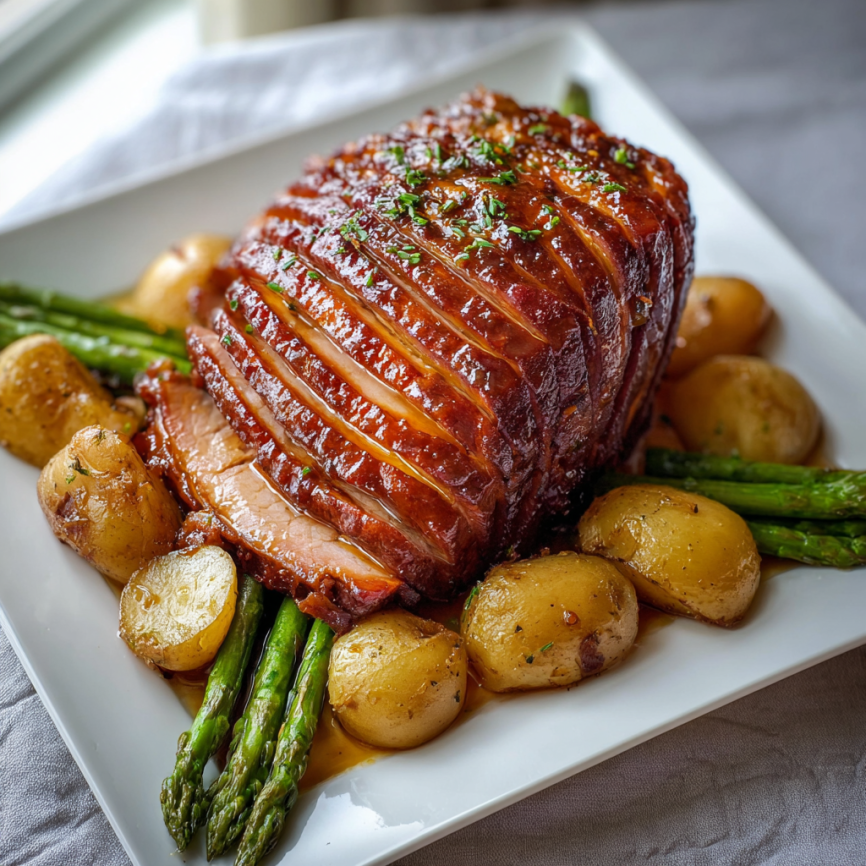There’s something magical about gathering around a table where the centerpiece dish makes everyone pause in appreciation. Growing up, I remember the anticipation that filled our kitchen as holiday roasts emerged from the oven, their caramelized surfaces glistening and aromatic steam rising into the air. Now, as someone who’s embraced plant-based cooking, I’ve discovered that same sense of celebration can come from an entirely vegan creation.
This Glazed Vegan Seitan Ham captures all those cherished memories while aligning with modern values of compassion and sustainability. The first time I served this dish at a family gathering, even my most skeptical relatives were amazed by its rich, smoky flavor and satisfying texture. What started as an experiment has become our new holiday tradition.
Why You’ll Fall in Love with This Recipe
Incredible Flavor Profile
Unlike many plant-based alternatives that can taste bland or overly processed, this seitan ham delivers complex, layered flavors. The combination of liquid smoke, aromatic spices, and umami-rich ingredients creates a depth that rivals traditional preparations. Meanwhile, the maple-mustard glaze adds a perfect balance of sweetness and tang that caramelizes beautifully in the oven.
Perfect Texture Every Time
Seitan’s naturally chewy, meat-like texture makes it ideal for this application. When prepared correctly, it slices cleanly and maintains its structure throughout cooking. Additionally, the protein develops a lovely crust on the outside while remaining tender inside.
Nutritionally Dense
Each serving provides substantial plant-based protein along with B vitamins from nutritional yeast. Furthermore, this dish contains no cholesterol and significantly less saturated fat than traditional ham, making it a heart-healthy choice for your celebration.
Essential Ingredients
Main Components
The foundation of this recipe relies on vital wheat gluten, which creates seitan’s characteristic texture. Nutritional yeast adds a subtle cheesy, nutty flavor while providing essential B vitamins. Moreover, the spice blend featuring smoked paprika, garlic powder, and warming spices like cloves and allspice creates that distinctive “ham” flavor profile.
Liquid smoke serves as the secret weapon here, imparting that essential smoky depth without any actual smoking. Combined with tomato paste for umami richness and maple syrup for subtle sweetness, these wet ingredients transform simple wheat gluten into something extraordinary.
The Show-Stopping Glaze
The maple-mustard glaze elevates this dish from good to spectacular. Pure maple syrup provides natural sweetness, while Dijon mustard adds sharp complexity. Brown sugar contributes to caramelization, and optional pineapple juice brings a hint of tropical brightness that complements the smoky flavors beautifully.
Step-by-Step Instructions
Preparation Phase
Start by preheating your oven to 350°F (175°C) and lining a baking sheet with parchment paper. This prevents sticking and ensures easy cleanup later. Next, gather all your ingredients and measure them accurately, as seitan requires precise ratios for optimal texture.
In a large mixing bowl, whisk together all dry ingredients: vital wheat gluten, nutritional yeast, and all the spices. This ensures even distribution throughout the final product. Separately, combine all wet ingredients in another bowl, whisking until the tomato paste is fully incorporated and no lumps remain.
Creating the Seitan Base
Pour the wet mixture into the dry ingredients gradually while stirring. Initially, the mixture will look shaggy and rough. However, as you continue mixing, it will begin forming a cohesive dough. Once it comes together, turn it onto a clean surface and knead vigorously for 3-4 minutes.
Proper kneading develops the gluten strands that give seitan its characteristic chewiness. The dough should become smooth, elastic, and slightly springy. If it feels too dry, add a tablespoon of vegetable broth; if too sticky, incorporate a bit more vital wheat gluten.
Shaping and First Bake
Form the kneaded dough into a loaf shape, roughly resembling a small ham. Wrap it tightly in aluminum foil, ensuring all seams are sealed to prevent moisture loss during cooking. Place the wrapped loaf on your prepared baking sheet and slide it into the preheated oven.
Bake for 1 hour, flipping the package halfway through to ensure even cooking. During this time, prepare your glaze by whisking together maple syrup, Dijon mustard, brown sugar, and pineapple juice until smooth.
The Glazing Finale
After the initial baking period, carefully remove the foil (watch for hot steam). The seitan should feel firm and hold its shape when gently pressed. Brush the entire surface generously with your prepared glaze, allowing it to pool slightly in any natural crevices.
Return the uncooked roast to the oven for an additional 15 minutes. This final baking allows the glaze to caramelize and develop a beautiful, sticky coating that’s both visually appealing and deliciously flavorful.

Serving Suggestions
Classic Holiday Presentation
Slice the glazed seitan ham into thick rounds and arrange on a platter garnished with fresh herbs like rosemary or thyme. Surround with roasted root vegetables such as carrots, parsnips, and Brussels sprouts for a colorful, festive display.
Traditional accompaniments work beautifully here. Serve alongside creamy mashed potatoes, tangy cranberry sauce, and steamed green beans for a complete holiday meal. The savory-sweet flavors complement these classic sides perfectly.
Modern Serving Ideas
For a contemporary twist, try serving thin slices on crusty artisan bread with whole grain mustard and pickled vegetables. Alternatively, dice leftover seitan ham for use in grain bowls, pasta dishes, or breakfast hash throughout the week.
Recipe Variations
Spice Adaptations
Customize the flavor profile by adjusting the spice blend. For a more traditional ham taste, increase the cloves and allspice. Those preferring a spicier version can add smoked paprika or a pinch of cayenne pepper.
Mediterranean flavors work wonderfully too. Substitute oregano and basil for some of the warming spices, and add sun-dried tomatoes to the wet ingredients for a different but equally delicious result.
Glaze Alternatives
While the maple-mustard combination is spectacular, other glazes work equally well. Try a balsamic reduction with brown sugar, or create an Asian-inspired version using soy sauce, rice vinegar, and sesame oil.
For those avoiding refined sugars, pure maple syrup or date paste can replace brown sugar in the glaze while maintaining that essential caramelized finish.
Make-Ahead Tips
Advance Preparation
This seitan ham actually improves with time, making it perfect for holiday meal planning. Prepare the entire roast up to three days ahead, storing it wrapped in the refrigerator. The flavors continue developing during storage, resulting in an even more delicious final product.
For longer storage, the fully cooked (but not glazed) seitan freezes beautifully for up to three months. Thaw completely in the refrigerator before applying glaze and reheating.
Reheating Instructions
When ready to serve, brush with fresh glaze and warm in a 325°F oven for 10-15 minutes until heated through. This method preserves the texture while refreshing the glossy exterior.
Leftover slices can be quickly reheated in a skillet with a splash of vegetable broth, maintaining their moisture and flavor.
Notas
Texture Considerations
The key to perfect seitan texture lies in proper kneading and moisture balance. Under-kneaded seitan will be dense and heavy, while over-kneaded versions can become tough. Aim for that sweet spot where the dough feels smooth and elastic but still yields slightly to pressure.
Additionally, wrapping tightly during the initial baking phase is crucial. This creates a steaming environment that keeps the seitan moist and tender throughout cooking.
Ingredient Substitutions
While vital wheat gluten cannot be substituted (it’s essential for seitan’s structure), other ingredients offer flexibility. Tamari can replace soy sauce for gluten-free needs, though note that vital wheat gluten itself contains gluten. Coconut aminos work as a soy-free alternative with slightly different flavor notes.
Vegetable broth can be substituted with mushroom broth for deeper umami flavors, or even white wine diluted with water for subtle complexity.

Frequently Asked Questions
Can I make this recipe gluten-free? Unfortunately, seitan is fundamentally made from wheat gluten, so this specific recipe cannot be made gluten-free. However, you could adapt the seasoning blend and glaze for use with other plant-based proteins like jackfruit or mushrooms.
Why is my seitan tough or rubbery? Tough seitan usually results from over-kneading or cooking at too high a temperature. Knead just until the dough becomes smooth and elastic, then stop. Also, ensure your oven temperature is accurate, as excessive heat can create a rubbery texture.
Can I steam instead of bake the seitan? Absolutely! Steaming creates an even more tender texture. Wrap the shaped dough in foil and steam for 45 minutes to 1 hour before unwrapping and glazing in the oven.
How do I know when the seitan is done cooking? Properly cooked seitan will feel firm but not hard when pressed gently. It should hold its shape when unwrapped and have a slightly springy texture. If it feels mushy, it needs more cooking time.
What’s the best way to slice seitan ham? Use a sharp knife and slice against the grain for the most tender pieces. Let the roast rest for 10 minutes after glazing before slicing, as this allows the juices to redistribute and prevents crumbling.
Can I double this recipe for a larger crowd? Yes, this recipe doubles easily. However, you may need to increase cooking time slightly for larger loaves. Check for doneness by pressing gently rather than relying solely on timing.
My glaze isn’t caramelizing properly. What went wrong? Glazes need sufficient sugar content and heat to caramelize. Ensure your oven temperature is correct and that you’re brushing on enough glaze. If the surface seems dry, brush with additional glaze halfway through the final baking period.
Prep Time: 20 minutes | Cooking Time: 1 hour 15 minutes | Total Time: 1 hour 35 minutes
Calories: 280 kcal per serving | Servings: 6

